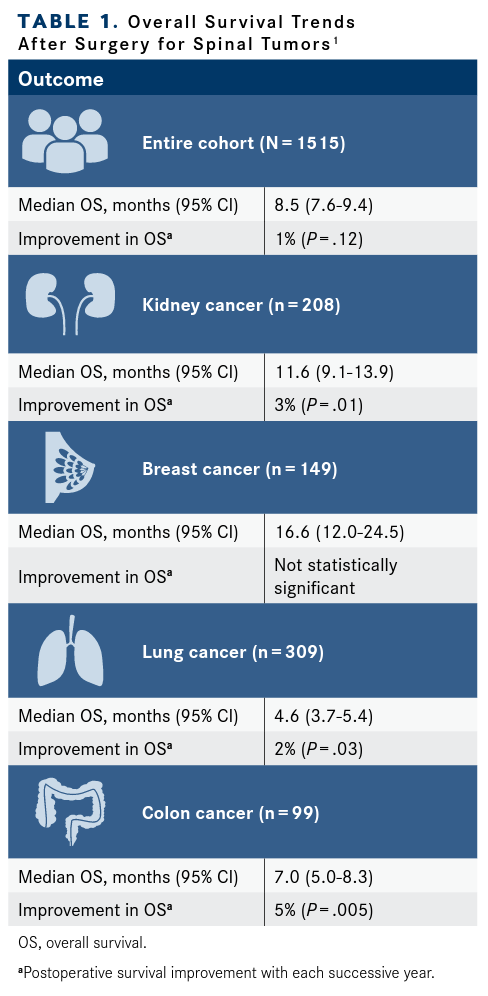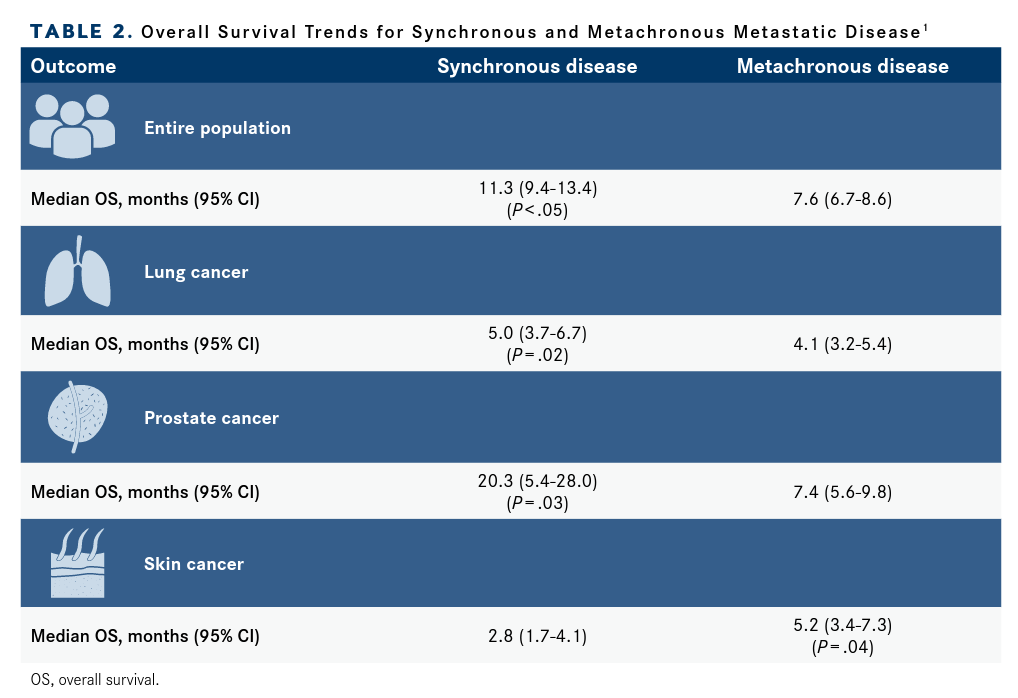Overall Survival After Surgery for Spinal Metastases Has Improved Over the Past Two Decades
Postoperative survival after surgery for spinal metastases has improved over the past 20 years, particularly in patients with kidney, breast, lung, and colon tumors metastatic to the spine.
Ori Barzilai, MD

Postoperative survival after surgery for spinal metastases has improved over the past 20 years, particularly in patients with kidney, breast, lung, and colon tumors metastatic to the spine, according to a retrospective analysis of patients treated at Memorial Sloan Kettering Cancer Center (MSK). Our findings highlight the importance of expert oncologic care for patients with spinal metastatic tumors.
The study, published recently in Neurosurgery, was the first to examine longitudinal survival trends after surgery in patients with spinal metastatic disease. We evaluated overall survival (OS) in 1515 patients with cancer who underwent surgery for metastatic epidural spinal cord compression or tumor-related mechanical instability between January 1998 and December 2017.1
Postoperative median OS was 8.5 months (95% CI, 7.6-9.4) for the entire cohort, which included patients with breast, prostate, renal cell, colon, lung, thyroid, and skin cancers. OS improved by 1% with each successive year of surgery (P = .12), amounting to a total of 20% over the study period.1
No specific years were associated with a significant improvement in survival for the whole cohort. However, a subanalysis revealed a substantial improvement in survival after 2016 for patients with breast cancer and after 2011 for patients with renal cell carcinoma. OS improved annually in patients with renal cell, lung, and colon cancers, but not in patients with thyroid, prostate, sarcoma, and skin cancers metastatic to the spine. Patients presenting with synchronous metastatic disease had a significantly higher median OS of 0.94 year compared with 0.63 year for patients with metachronous disease (P = .00001).1
While researchers have made significant progress delineating patient-specific predictors of survival, including targets for tyrosine kinase inhibitors, monoclonal antibodies, and hormonal therapy,2-4 patients with targetable tumor drivers represent only a part of the population that undergoes surgery for spinal metastases. Therefore, primary tumor site remains a significant predictor of survival, as confirmed by our present study.1
Mark H. Bilsky, MD

At MSK, we are leaders in treating spinal metastases. Many centers worldwide have adopted our treatment models, which include minimally invasive spine surgery, advanced radiation techniques, and interventional procedures. Our multidisciplinary team developed the neurologic, oncologic, mechanical, and systemic (NOMS) Framework, an evidence-based approach to determining the optimal therapy for patients with spinal metastases, 2 decades ago. It incorporates neurologic, oncologic, mechanical instability, and systemic disease considerations, and has been adapted over time to integrate advances in radiation, surgery, and systemic therapies.5
SURGICAL TREATMENT FOR SPINAL METASTASES
The spine is among the most common sites of metastatic disease. The treatment of metastatic spinal tumors serves an essential palliative function by improving or preserving the quality of life, neurologic function, and spinal stability.
In a randomized controlled trial, Patchell et al found that surgery followed by radiotherapy resulted in superior functional outcomes and pain control compared with radiotherapy alone in patients with symptomatic solid spinal metastases. Further, surgery resulted in a higher probability of ambulation restoration, longer duration of ambulation preservation, and a small survival advantage.6
Surgery definitely improves the quality of life for patients with symptomatic spinal metastases,7,8 and research has demonstrated the correlation among baseline ECOG performance status, quality of life, neurologic, and functional status with survival.9 There is also emerging evidence for survival improvement with ablative therapy for oligometastatic disease.10
Over the past 20 years, advances in early diagnosis and treatment have greatly increased OS for patients with cancer.11 For example, the 5-year relative survival improved from 35% in 1950 to 1954 to 70% in 2009 to 2015.12 However, these statistics include patients with local, regional, and metastatic cancers, with minimal survival trend information available for patients with the last. It has been unclear whether improvements in survival have been conferred to patients requiring surgery for metastatic spinal disease because patients present at various treatment stages.13
Treatment decisions for patients with spinal metastases require careful consideration of expected survival and quality of life. As more therapeutic agents and potential salvage therapies become available for patients with metastatic cancer, it has been assumed that longer OS has translated into longer postoperative survival, placing greater emphasis on maintaining the quality of life and durable local tumor control.14-18
STUDY DESIGN
We analyzed survival outcomes for patients 18 years and older who underwent surgical intervention for metastatic spinal disease at MSK between January 1998 and December 2017. The NOMS decision framework guided the development of individualized treatment plans for the entire cohort.1
Primary surgical indications included high-grade metastatic epidural spinal cord compression and/or mechanical instability. All patients requiring spinal cord decompression received hybrid therapy consisting of separation surgery and radiotherapy. Patients who required spinal stabilization had instrumentation placed with an open or minimally invasive posterior approach. The surgical technique was uniform and did not vary by tumor type over time. For patients who had multiple surgical interventions, the first surgery was the index surgery. All patients also underwent radiation therapy using conventional external beam or stereotactic body radiation therapy.1
Synchronous disease was defined as surgery for spinal metastases within 3 months of primary cancer diagnosis. Metachronous disease was defined as spinal metastases occurring 3 months or later after primary cancer diagnosis.1
STUDY FINDINGS
The mean age at index surgery was 60 years (range, 18-92), with males representing 60% of the study population. There were 25 different cancer types across the entire cohort, with metastatic lung, breast, prostate, renal, colon, skin, sarcoma, and thyroid cancers representing 75% of cases.1
The majority of metastases were located in the thoracic spine (62%), followed by lumbar (25%), cervical (11%), and sacral levels (1.4%). Surgical volume increased over time, with 43% of surgeries occurring between 2013 and 2017.
Median OS for the entire cohort was 8.5 months (95% CI, 7.6-9.4). We observed an improvement in OS of 1% with each successive year over the 20 years (P = .12). A recursive partitioning analysis (RPA) did not reveal a split year for improved survival.
The 30-day mortality rate for the total cohort was 5.5%, and the 90-day mortality rate was 23.7%. There was no statistically significant change in the 30- or 90-day mortality rate over the study period (P = .81 and P = .99, respectively).1
Notably, we found significant differences in survival outcomes among primary tumor sites as follows (TABLE 11).
TABLE 1. Overall Survival Trends After Surgery for Spinal Tumors

Kidney Cancer
A total of 208 patients (14%) underwent surgery to treat kidney cancer metastatic to the spine. The median OS was 11.6 months (95% CI, 9.1-13.9). Postoperative survival rates improved 3% (95% CI, 1%-6%), with each successive year (P = .01). RPA showed that patients who had surgery after 2010 had a 41% decreased risk of death compared with those who had surgery before 2011 (95% CI, 20%-57%). Patients who underwent surgery before 2011 had a median OS of 9.4 months (95% CI, 6.1-12.1), whereas those who had surgery after 2010 had a much higher OS of 16.3 months (95% CI, 10.7-25.9). Finally, 90-day mortality rates decreased from 17% to 8% after 2010 (P = .049). There was no statistically significant change in 30-day mortality.1
Breast Cancer
Median OS was 16.6 months (95% CI, 12.024.5) for 149 patients (9.8%) who underwent surgery to treat breast cancer metastatic to the spine. We did not find a statistically significant annual trend toward improved OS. However, RPA revealed a statistically significant 69% (95% CI, 23%-87%) decrease in the risk of death among patients who had surgery after 2016, with a median OS of 14.0 months (95% CI, 9.3-20.4) among those who had surgery before 2015. There were no statistically significant differences in 30-day or 90-day mortality rate.1
Lung Cancer
Median OS was 4.6 months (95% CI, 3.7-5.4) for 309 patients (20%) who had surgery to treat patients with lung cancer metastatic to the spine. There was a 2% (95% CI, 0%-5%) improvement in survival with each progressive year of surgery (P = .03). RPA did not reveal a split in the year of surgery and its association with OS.1
Colon Cancer
Median OS was 7 months (95% CI, 5.0-8.3) for 99 patients (7%) who underwent surgery to treat colon cancer metastatic to the spine. There was a 5% (95% CI, 2%-9%) improvement in OS with each progressive year of surgery (P = .005). As with lung cancer, RPA did not reveal a split in the year of surgery and its association with OS.1
Thyroid, Prostate, Sarcoma, and Skin Cancer
We found no significant trends in OS for patients with thyroid, prostate, sarcoma, and skin cancer metastases.1
Metachronous vs Synchronous Metastatic Disease
Patients with synchronous spinal metas-tases requiring surgery had a statistically significantly longer median OS of 11.3 months (95% CI, 9.4-13.4) compared with 7.6 months (95% CI, 6.7-8.6) for patients who underwent surgery for metachronous spinal metastases (P < .05; TABLE 2).1
Patients with lung cancer undergoing surgery for synchronous metastatic disease had an OS of 5 months (95% CI, 3.7-6.7), significantly better than 4.1 months (95% CI, 3.2-5.4) for their counterparts with metachro-nous metastatic disease (P = .02). Patients with synchronous prostate cancer metasta-ses had a much-improved OS of 20.3 months (95% CI, 5.4-28.0) compared with 7.4 months (95% CI, 5.6-9.8) for those with metachronous disease (P = .03).1
Interestingly, patients with metachronous skin cancer spinal metastases experienced a longer OS of 5.2 months (95% CI, 3.4-7.3) vs 2.8 months (95% CI, 1.7-4.1) for those with synchro-nous metastases (P = .04), supporting potential consideration of additional lines of systemic therapy in select patients. RPA analysis failed to identify a split in the year of surgery and its association with OS for patients with either synchronous or metachronous metasta-ses. However, there was a 1% improvement in survival with each progressive year of surgery for patients who had surgery for metachronous metastases (P = .06).1
TABLE 2. Overall Survival Trends for Synchronous and Metachronous Metastatic Disease

IMPROVING OUTCOMES FOR PATIENTS WITH SPINAL METASTASES
Over the past 2 decades, new hormone and chemotherapy agents, targeted therapy, and immunotherapy have led to improved survival rates for patients with cancer in general.19,20 Advances in radiotherapy techniques have allowed targeted, high-dose radiation and the delivery of ablative radiation while sparing healthy tissues.21 Surgical technology and techniques have also improved, resulting in better intraoperative visualization and navigation, tumor resection methods, functional restoration, and minimally invasive approaches. Together, these advances have led to improved survival through decreased risk of local recurrence of primary tumors and improved systemic and local control of metastatic disease.
In our present study, the improvements we observed in postoperative survival for patients with kidney, lung, and colon cancers metastatic to the spine showed changes similar to the survival improvements in the general population with these cancers.1
At MSK, dedicated specialists in our Multidisciplinary Spine Tumor Serviceevaluate and treat more than 1500 spine tumors a year. We create an indi-vidualized treatment plan for each patient to improve neurologic function and mobility, stabilize the spine, control tumor growth, and improve quality of life.
Each spine surgeon operates on more than 150 spine and spinal cord tumors annually, but most patients are treated effectively with noninvasive, stereotactic radiation therapy, or proton beam therapy. Radiation is sometimes combined with percutaneous kyphoplasty to provide support and relieve pain. Combining separation surgery with radiosurgery has revolutionized our ability to provide effective tumor control, reduce complications, shorten hospital stays, and return patients to systemic therapy quickly.
We are currently conducting 4 clinical trials for patients with spinal metastases as follows:
- a study of preventive radiation therapy for patients with high-risk bone metas-tases that are not causing significant pain (NCT03523351);
- a phase 2 study of proton radiation ther-apy vs partial photon radiation therapy to treat leptomeningeal metastases in the brain and spine (NCT04343573);
- a phase 2/3 study of 131I-omburtamab radioimmunotherapy in children with neuroblastoma that has spread to the brain or spinal cord or the lining around the brain (NCT03275402); and
- a phase 1/2 study of nivolumab and stereotactic radiosurgery for recurrent chordoma (NCT02989636).
The study was funded in part through the National Institutes of Health/National Cancer Institute Support Grant P30 CA008748. The authors have no personal, financial, or institutional interest in any of the drugs, materials, or devices described in the study. Laufer discloses consulting for Depuy/Synthes, Medtronic, Spinewave, Brainlab, and Globus. Bilsky discloses royalties for Depuy/Synthes and Globus.
References
- Rothrock RJ, Barzilai O, Reiner AS, et al. Survival trends after surgery for spinal metastatic tumors: 20-year cancer center experience. Neurosurgery. 2021;88(2):402-412. doi:10.1093/neuros/nyaa380
- Sciubba DM, Goodwin CR, Yurter A, et al. A systematic review of clinical outcomes and prognostic factors for patients undergoing surgery for spinal metastases secondary to breast cancer. Global Spine J. 2016;6(5):482-496. doi:10.1055/s-0035-1564807
- Ahangar P, Aziz M, Rosenzweig DH, Weber MH. Advances in personalized treatment of metastatic spine disease. Ann Transl Med. 2019;7(10):223. doi:10.21037/atm.2019.04.41
- Choi BD, Shankar GM, Sivaganesan A, Van Beaver LA, Oh K, Shin JH. Implication of biomarker mutations for predicting survival in patients with metastatic lung cancer to the spine. Spine (Phila Pa 1976). 2018;43(21):E1274-E1280. doi:10.1097/BRS.0000000000002683
- Laufer I, Rubin DG, Lis E, et al. The NOMS framework: approach to the treatment of spinal metastatic tumors. Oncologist. 2013;18(6):744-751. doi:10.1634/theoncologist.2012-0293
- Patchell RA, Tibbs PA, Regine WF, et al. Direct decompressive surgical resection in the treatment of spinal cord compression caused by metastatic cancer: a randomised trial. Lancet. 2005;366(9486):643-648. doi:10.1016/S0140-6736(05)66954-1
- Fehlings MG, Nater A, Tetreault L, et al. Survival and clinical outcomes in surgically treated patients with metastatic epidural spinal cord compression: results of the prospective multicenter AOSpine study. J Clin Oncol. 2016;34(3):268-276. doi:10.1200/JCO.2015.61.9338
- Hussain I, Barzilai O, Reiner AS, McLaughlin LA, Bilsky MH, Laufer I. Validation of spinal instability neoplastic score components through patient-reported outcomes. Spine J. 2017;17(10):S181. doi:10.1016/j.spine.2017.07.330
- Falicov A, Fisher CG, Sparkes J, Boyd MC, Wing PC, Dvorak MF. Impact of surgical intervention on quality of life in patients with spinal metastases. Spine (Phila Pa 1976). 2006;31(24):2849-2856. doi:10.1097/01.brs.0000245838.37817.40
- Iyengar P, Wardak Z, Gerber DE, et al. Consolidative radiotherapy for limited metastatic non-small-cell lung cancer: a phase 2 randomized clinical trial. JAMA Oncol. 2018;4(1):e173501. doi:10.1001/jamaoncol.2017.3501
- Klimo P Jr, Thompson CJ, Kestle JRW, Schmidt MH. A meta-analysis of surgery versus conventional radiotherapy for the treatment of metastatic spinal epidural disease. Neuro Oncol. 2005;7(1):64-76. doi:10.1215/S1152851704000262
- U.S. mortality data 1969-2018. National Cancer Institute – Surveillance, Epidemiology, and End Results Program. Accessed March 12, 2021. https://seer.cancer.gov/mortality/
- Kummar S, Chen HX, Wright J, et al. Utilizing targeted cancer therapeutic agents in combination: novel approaches and urgent requirements. Nat Rev Drug Discov. 2010;9(11):843-856. doi:10.1038/nrd3216
- Richards L, Misra V, Verma R, Greenhalgh S. Metastatic spinal cord compression (MSCC) – collaborative work between the Tertiary Cancer Centre and the Specialist Spinal Centre. Spine J. 2017;17(3 Suppl):S30-S31. doi:10.1016/j.spinee.2016.12.095
- Laufer I, Iorgulescu JB, Chapman T, et al. Local disease control for spinal metastases following “separation surgery” and adjuvant hypofractionated or high-dose single-fraction stereotactic radiosurgery: outcome analysis in 186 patients. J Neurosurg Spine. 2013;18(3):207-214. doi:10.3171/2012.11.SPINE12111
- Bate BG, Khan NR, Kimball BY, Gabrick K, Weaver J. Stereotactic radiosurgery for spinal metastases with or without separation surgery. J Neurosurg Spine. 2015;22(4):409-415. doi:10.3171/2014.10.SPINE14252
- Barzilai O, Amato MK, McLaughlin L, et al. Hybrid surgery-radiosurgery therapy for metastatic epidural spinal cord compression: a prospective evaluation using patient-reported outcomes. Neurooncol Pract. 2018;5(2):104-113. doi:10.1093/nop/npx017
- Barzilai O, McLaughlin L, Amato M-K, et al. Predictors of quality of life improvement after surgery for metastatic tumors of the spine: prospective cohort study. Spine J. 2018;18(7):1109-1115. doi:10.1016/j.spinee.2017.10.070
- Chakravarty D, Gao J, Phillips SM, et al. OncoKB: a precision oncology knowledge base. JCO Precis Oncol. 2017;2017:PO.17.00011. doi:10.1200/PO.17.00011
- Miller KD, Nogueira L, Mariotto AB, et al. Cancer treatment and survivorship statistics, 2019. CA Cancer J Clin. 2019;69(5):363-385. doi:10.3322/caac.21565
- Vellayappan BA, Chao ST, Foote M, et al. The evolution and rise of stereotactic body radiotherapy (SBRT) for spinal metastases. Expert Rev Anticancer Ther. 2018;18(9):887-900. doi:10.1080/14737140.2018.1493381




